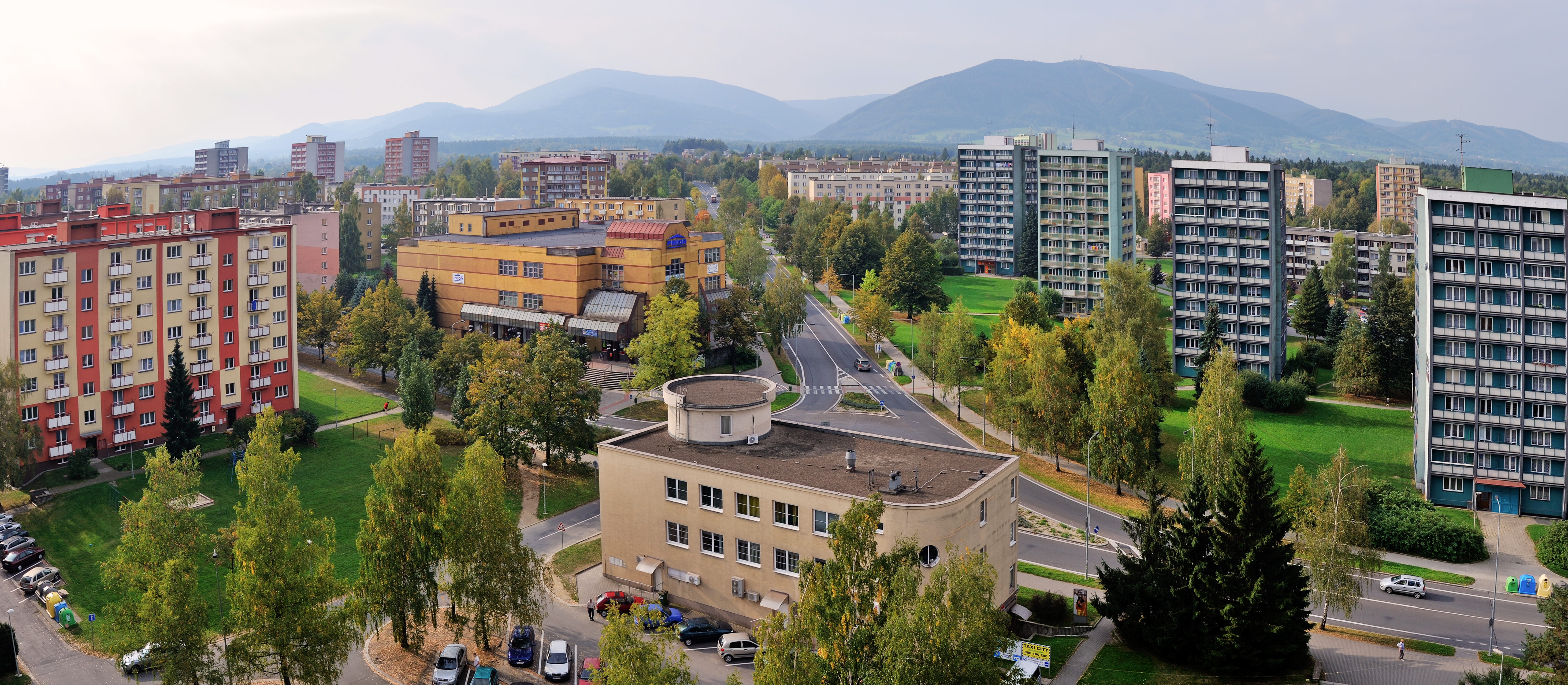Statutory town Třinec
Třinec is an industrial town in the eastern part of the Czech Republic, surrounded by charming hills and mountains.
Třinec is an industrial town on the border with Poland, 7 km south of Český Těšín at the mouth of the river Tyrka into the river Olše.
It is surrounded by the charming Moravian-Silesian and Silesian Beskydy Mountains. The dominant feature is the Javorový Hill (1032 m above sea level). In the vicinity of the town there are deep picturesque valleys attracting hikers, mountain bikers and in winter downhill and cross-country skiers.
Basic Information
City area: 95.6 km2
Population: approximately 35 000 residents
Altitude: 306 m above sea level.
Geographic coordinates:
Parts of the town: Lyžbice, Dolní Lištná, Horní Lištná, Oldřichovice, Karpentná, Tyra, Guty, Nebory, Kanada, Konská, Kojkovice, Osůvky, Ropice, Staré Město.
Mayor: RNDr. Věra Palkovská (Independent party)
Contact Information
Magistrát města Třince
Jablunkovská 160
739 61 Třinec
E-mail: sekretariat@trinecko.cz
Telephone: +420 558 306 111
Official website: www.trinecko.cz
Surroundings of Třinec
On the western side of the town is the Kanada district and further towards Frýdek-Místek is the Nebory district. Along the railway, towards Český Těšín, lies Konská, on which territory Třinecké Železárny, one of the largest metallurgical enterprises in the Czech Republic, are located. The Moravian-Silesian Beskydy Mountains are located in the vicinity of Třinec and the Silesian Beskydy Mountains are to the east. These two Carpathian mountain ranges are separated from each other by the Jablunkov furrow, the axis of which is formed by the river Olše, which flows through Třinec. Třinec is also the starting point of hiking trails to the surrounding peaks of Javorový vrch, Ostrý and Velká Čantoryje.
Transport connections
To get to Třinec you can use the international road E 75, which connects Třinec with Český Těšín, where there is an international border crossing to Poland. Třinec can now also be reached via the I/11 road, which continues to Bystřice, where it is again connected to the international road E 75.
Třinec is also easily accessible by rail as it lies on the international train corridor between Bohumín and Žilina with fast train connections from all over the Czech Republic. Třinec has a total of two train stops - Třinec and Třinec - Centrum. Ještě máme Konskou.
Public bus transport in Třinec and its surroundings is provided by the company ARRIVA MORAVA a.s.
History
The village of Třinec was founded in the 14th century, but the first written mention dates back to 1444. In the 16th century, Třinec came into the possession of the Mitmajers of Blogotic and remained in their ownership at the beginning of the following century. At that time the village had 24 homesteads. Iron was produced here as early as Roman times. In the 18th and 19th centuries, ore was mined in the surrounding area (the first deposit of a poor iron ore called teschenite was on Ostrý Vrch) and limestone, charcoal was burnt in the mills in the surrounding forests, and malleable iron was produced in special furnaces. In the first half of the 19th century, Třinec was still one of the many agricultural villages owned by the Těšín Chamber. An important event in the history of the village was the establishment of the Třinec Ironworks in 1839. The construction of the Košice-Bohumín railway in 1869-1871, followed by the rapid development of public institutions, was of fundamental importance for the development of the ironworks and thus the whole village.
1920 - Třinec was annexed to the Czech Republic on the basis of the peace agreement with Poland and the decision of the commission of ambassadors in the Belgian Spa.
In 1931 the village was promoted to a town.
Gradually, some neighbouring villages joined Třinec. Thanks to its civic and cultural amenities, the new centre of the town became the district of Lyžbice. On the slopes of Jahoda in the Dolní Líštná cadastre, the Sosna housing estate was built. An important part of the town is Oldřichovice, which is situated at the foot of Javorový (1032 m above sea level). Further south, below the slopes of Kozinec and Ostrý, lies Karpentná. In the narrow valley between Javorový and Ostrý is the village of Tyra, where a number of recreational centres and cottages have been built over the years.
As of 1st September 2018, Třinec became a statutory town.
For more information about the history of the town, please visit www.trinecko.cz.
Sports facilities
Třinec has an excellent ice hockey team, a great tradition of weightlifting, orienteering (runners from Třinec have achieved many international successes), football (II. league), a high quality level of Greco-Roman wrestling, Thai boxing, bodybuilding, cycle-cross and road cycling. The sports complex on Lesní Street has a winter stadium, a summer swimming pool, mini-golf, tennis courts, a sports hall, an indoor swimming pool, saunas, a football and athletics stadium, an artificial turf pitch, a grass training field and a cycle-cross track.


